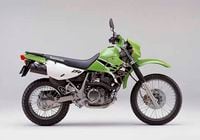Q: I have a 1995 Kawasaki KLR650 that I ride primarily on the street. It has inner tubes in both tires. Last week I got a flat tire on the freeway, and the air leaked out so fast I barely made it to the shoulder without crashing. Then I had no way to get the tube out to patch it. This got me thinking about tubeless tires and how much easier it would have been to plug the hole and get back on the road. Can I convert my KLR’s wheels so they work with tubeless tires by lacing tubeless rims to my hubs?
Sam Jacobs, San Jose, CA
A: Look closely and you'll see the spoke wheels on adventure bikes like BMW's GS and Yamaha's Ténéré can use tubeless tires because the spokes attach to the rim outside of the air chamber. Because the section of the rim underneath the tire has no spoke holes that air can leak through, it's possible to use tubeless tires.
Converting your KLR's wheels to tubeless by swapping rims won't work. The spoke nipples in a tubeless spoked wheel are in the hub, and in your KLR they're in the rim; the spokes are shaped differently too. But there's another alternative: Woody's Wheel Works (woodyswheelworks.com) uses a glue/silicone process to seal the spoke holes in the rim and keep air from leaking out past the nipples. The sealed rim can then run a tubeless tire, which can be plugged like any other tubeless tire in case of a flat.
You can pad your chances on tubed tires by maintaining proper inflation pressures and by using thicker, more durable inner tubes. (The original-equipment tubes are typically thin and cheap.) During replacement, very carefully inspect the rim for burrs or other debris that could puncture the tube, and make sure the rim strip is in good condition. Finally, understand that tubes are not lifetime purchases. They wear out from friction inside the tire—exacerbated by low inflation pressures—and should be replaced with the tires.


/cloudfront-us-east-1.images.arcpublishing.com/octane/IN263JIBTBCD3O265IMSCW6OZM.jpg)
/cloudfront-us-east-1.images.arcpublishing.com/octane/SMAQ354X2JH7NJATXNSQY4NRS4.jpg)
/cloudfront-us-east-1.images.arcpublishing.com/octane/GGOH2AQRSVHY5C5JLNEVYLB5SU.jpg)
/cloudfront-us-east-1.images.arcpublishing.com/octane/TJJEHV3ATZFFXHUYZABHXKE2DI.jpg)
/cloudfront-us-east-1.images.arcpublishing.com/octane/WIC4RXQ36BAXNIW6U4UJ3XDLKI.jpg)
/cloudfront-us-east-1.images.arcpublishing.com/octane/B4PQZLY4LBHITGE5ZRRM2N5YNU.jpg)
/cloudfront-us-east-1.images.arcpublishing.com/octane/OBYS7KWZUJFCHD44YPTSVM5EF4.jpg)
/cloudfront-us-east-1.images.arcpublishing.com/octane/FY7ZXYBT4NH2NGYQIWQVITS4AM.jpg)
/cloudfront-us-east-1.images.arcpublishing.com/octane/JPET6WQUDZEYLNXVY5LRNDRPLA.jpg)
/cloudfront-us-east-1.images.arcpublishing.com/octane/EY6P2QIFQJCDTNOMR3JB7WJED4.jpg)
/cloudfront-us-east-1.images.arcpublishing.com/octane/V2U6JB7KXNCQRN4OW6HNJTVMZQ.jpg)
/cloudfront-us-east-1.images.arcpublishing.com/octane/AMS43BT5ABH77NY7XKLCSZCNM4.jpg)
/cloudfront-us-east-1.images.arcpublishing.com/octane/NTK2ASYKUBDW5MQDWQLVQYOELY.jpg)
/cloudfront-us-east-1.images.arcpublishing.com/octane/SX7R3KCIANGDBGF45O73F543TM.jpg)
/cloudfront-us-east-1.images.arcpublishing.com/octane/ZTW4V7RAPFG6RFWJRXR2IX5ZQ4.jpg)
/cloudfront-us-east-1.images.arcpublishing.com/octane/EPRSLPIUTBC5RPD7R263BPV2D4.jpg)
/cloudfront-us-east-1.images.arcpublishing.com/octane/EMJ4I2T4HVCRVJPZ3UJFVMRDHA.jpg)
/cloudfront-us-east-1.images.arcpublishing.com/octane/CBDAM3VMJNFDBLE7Y3FY7RD5BY.jpg)
/cloudfront-us-east-1.images.arcpublishing.com/octane/CCEB3TNMU5FH3OZ4FKJ7DA2LBA.jpg)
/cloudfront-us-east-1.images.arcpublishing.com/octane/VV6N3KUWEVFJJD7F7VX6ICOH7Q.jpg)
/cloudfront-us-east-1.images.arcpublishing.com/octane/R55SVEXZ5VA2LCWFWYR647ASX4.jpg)
/cloudfront-us-east-1.images.arcpublishing.com/octane/MYWIEFOQ6JCCNDR4OBF5PU5LVE.jpg)
/cloudfront-us-east-1.images.arcpublishing.com/octane/OOZ3C4GCUJGRNONDI6DHVM57GI.jpg)
/cloudfront-us-east-1.images.arcpublishing.com/octane/JEKB3CMWXZD6ZAVFEDKLOQ5FNY.jpg)